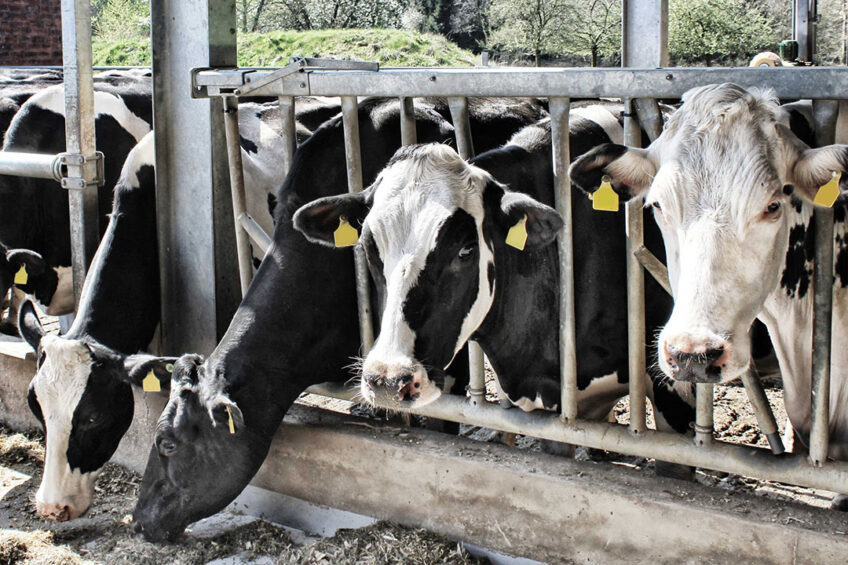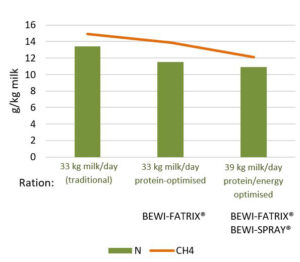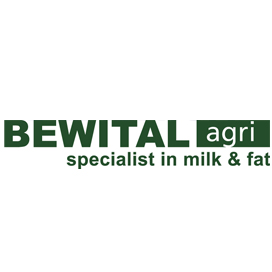Sustainable milk production through more efficient feeding

In the context of the discussions on the German and European sustainability strategy, agriculture and dairy farming are in the focus. The demand for sustainable milk production is often associated with the term efficiency at various levels. Feeding plays a very important role and has an influence on the profitability, metabolic stability, health and fertility of the dairy cow. At the same time, ration optimisation should consider the effect on the environmentally relevant emissions of nitrogen and climate-relevant gases (especially methane and ammonia).
The term efficiency is now used in a wide variety of contexts. “Efficiency” describes the ratio of the quantity of a performance characteristic in relation to a production factor, efficiency = output/input. Focusing on efficiency characteristics maximises output in relation to input. However, advantages and disadvantages that occur elsewhere are not considered. An example of this is feed and energy efficiency in milk production (kg milk per kg feed or MJ energy produced in milk per MJ NEL energy input). If the efficiency curves are considered, their shortcoming becomes apparent: The highest feed and energy efficiency are found in the first 80 days of lactation. However, these arithmetically high values are based on the mobilisation of energy from the mobilisation of body reserves. Conversely, the regeneration of body reserves, the build-up of body mass, leads to mathematically low efficiency values from the middle of lactation.
Concentrating on a mathematically high feed or energy efficiency in the short term can even increase the energy deficit at the beginning of lactation and result in long-term losses in metabolic stability, health and fertility. “Efficiency” values can be meaningfully used as “nitrogen utilisation efficiency”, especially in the area of protein and nitrogen supply. Here, the output of milk protein is set in relation to the input via feed protein.
Protein supply in line with requirements
The basis for good and sustainable milk yields is formed by supplying the dairy cows with energy and protein in line with their needs. The protein supply directly influences the nitrogen utilisation efficiency via optimal rumen fermentation and thus also the N emission. Optimising the nitrogen metabolism of dairy cows can thus sustainably reduce N emissions from milk production in the long term and at the same time make economic sense.
As milk yield increases, so do the demands on the protein quality of the feed. The importance of the proportion of stable feed protein increases. Since the dairy cow is also dependent on the amino acid supply at the small intestine, the importance of the amino acid pattern of the feed increases with increasing protein stability.
Rumen-protected amino acids: More milk, less N emission
In our own studies, an addition of rumen-protected lysine and methionine (Bewi-Fatrix LM 101) to an otherwise balanced ration increased milk yield by 2.3 kg per cow and day. At the same time, the utilisation of feed nitrogen for milk production increased from 31.7% to 33.9%. The standard emissions given by the DLG in the “Bilanzierung der Nährstoffausscheidungen landwirtschaftlicher Nutztiere” (DLG, 2014) result in an N-efficiency or utilisation of feed nitrogen for milk formation of 22% to 28%. Through an adapted protein supply in connection with an addition of the first-limiting amino acids in rumen-protected form, the protein utilisation could be increased to 34% with rations customary in practice in several trials. This is accompanied by a significant reduction in N emission via faeces and urine. At the same time, the potential for gaseous ammonia emissions is significantly reduced. Up to 90% of ammonia emissions (NH3) and about 15% of methane emissions (CH4) are attributed to livestock farming worldwide. Both trace gases have a clear climate relevance.
Rumen-stable fats: More energy without methane formation
For CH4, a 23-fold effect in terms of greenhouse gas potential is assumed compared to CO2. In contrast to NH3, CH4 from livestock farming is mainly attributed to ruminants. The share from the large intestine digestion of monogastrics is significantly lower. CH4 is inevitably produced during microbial carbohydrate degradation in the rumen by methanogenic bacteria. Methane emission in ruminants can vary between 2% (high-concentrate feeding) and 15% (high-fibre feeding) of the gross energy consumed and represents an energy loss for the animal. Depending on feed intake, performance level, ration and other factors, between 20 g and 25 g of CH4 per kg of dry feed mass are excreted. Due to the high importance of the maintenance requirement of the dairy cow, it quickly becomes clear that the greatest reduction potential regarding methane emission per kg of milk is the performance level of the dairy cow.
The amount of methane formed in the rumen and released into the environment depends primarily on the organic mass fermented in the rumen. An addition of energy sources that are not broken down in the rumen, such as rumen-stable fats, therefore does not increase the amount of methane formed per day but can make a decisive contribution to improving the energy supply of the dairy cow and thus to increasing the milk yield.
Rumen-stable fats and amino acids offer many advantages
Rumen-stable fats (Bewi-Spray) allow an effective energetic upgrading of the ration without providing a substrate for methanogenic microorganisms. Methane emission is even reduced in relation to the higher energy supply per unit of “milk produced”.
Figure 1- Emission of nitrogen and methane per kg of milk with and without protein/energy optimisation and use of Bewi-Fatrix and Bewi-Spray products.

Brade, 2014; DLG, 2014; own calculations
By using rumen-protected amino acids (Bewi-Fatrix and rumen-stable fats Bewi-Spray) dairy cow rations can be optimised in terms of protein and energy source use. At the same time, these products enable the targeted reduction of nitrogen and methane emission per kg of milk (Figure 1).
References are available on request.


